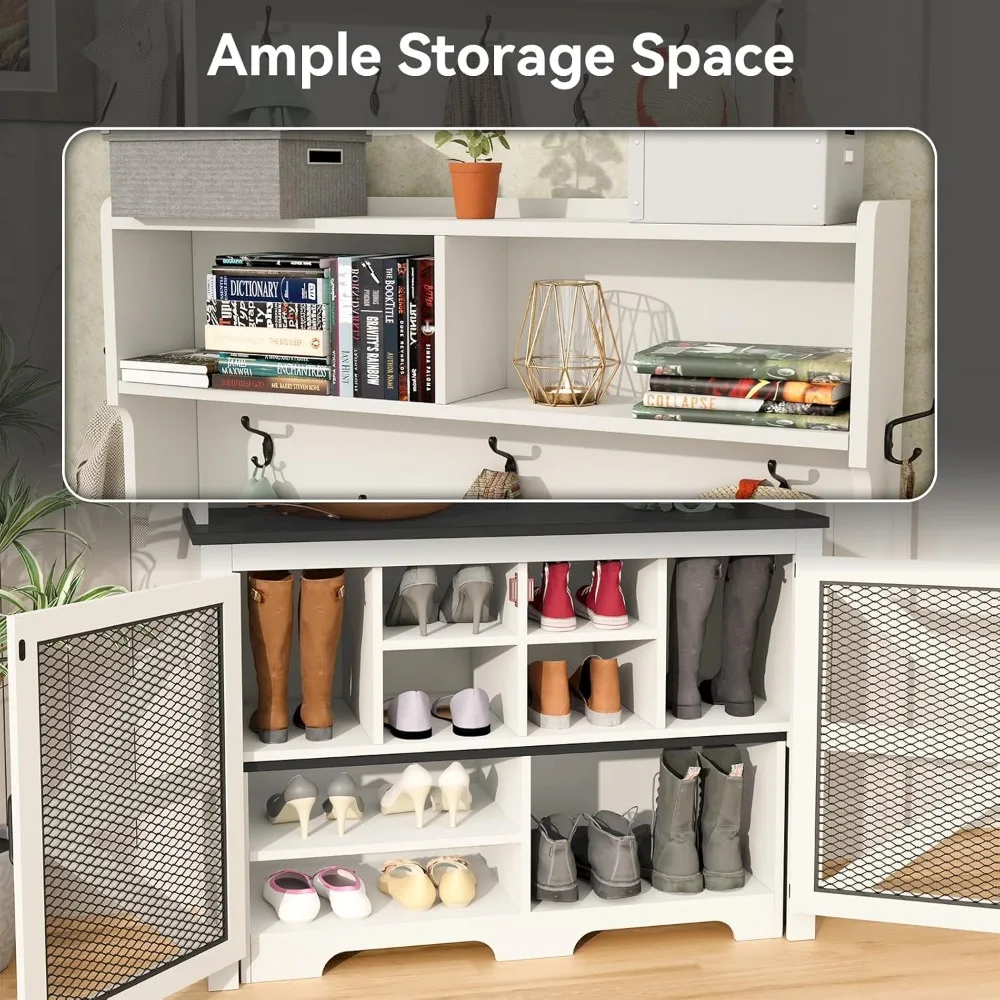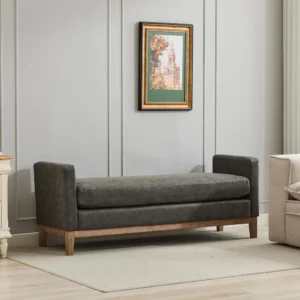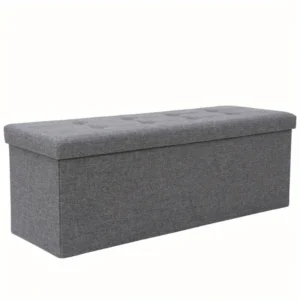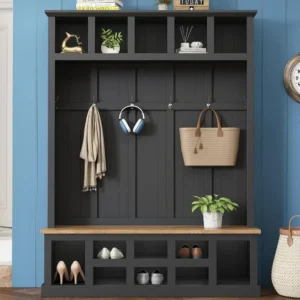Introduction
The entryway is your home’s first impression and deserves thoughtful organization that balances style with practicality. Entry furniture with open shelving offers the perfect solution, combining decorative display opportunities with accessible storage for everyday essentials. Unlike closed cabinets or drawers, open shelving creates visual breathing space while keeping frequently used items within easy reach.
A well-designed entryway sets the tone for your entire home while solving one of the most common household challenges: controlling clutter where it typically accumulates first. The beauty of entryway benches and other entry furniture with open shelving is their dual functionality—they not only organize your space but also serve as display areas for personal touches that welcome guests.
Key benefits of incorporating open shelving into your entryway include:
- Accessibility: Grab-and-go convenience for items you need when heading out the door
- Visual openness: Creates an airy feel even in smaller entryways
- Display versatility: Showcase decorative elements alongside practical storage
- Adaptability: Easily reconfigure for seasonal needs or changing storage requirements
Whether your home features a spacious foyer or a modest hallway entry, there’s an open shelving solution that can transform your entrance from a chaotic drop zone into an organized, welcoming space. This guide explores the various options available and provides practical advice for selecting, styling, and maintaining entry furniture with open shelving that complements your home’s aesthetic while addressing your specific storage needs.
Types of Entry Furniture with Open Shelving
Entry furniture with open shelving comes in diverse forms, each designed to address specific spatial requirements and functional needs. From slim console tables perfect for narrow hallways to comprehensive hall trees that handle everything from coats to keys, these versatile pieces combine practical storage with decorative display opportunities.
The material choice significantly impacts both aesthetics and durability. Solid wood options provide timeless warmth and exceptional longevity, while metal frames offer contemporary appeal with sturdy support. Glass shelving creates a lighter visual footprint, ideal for smaller spaces, and composite materials often provide budget-friendly alternatives with various finish options.
When exploring space-saving entryway ideas, consider how different furniture types serve distinct purposes. Console tables offer surface area without consuming floor space, benches provide seating plus storage, hall trees consolidate multiple functions, and wall-mounted solutions maximize vertical space. Each category comes with its own set of advantages designed to accommodate different entryway configurations and household needs.
Console Tables with Open Shelving
Console tables with open shelving represent one of the most versatile entryway solutions, particularly for spaces where floor area is at a premium. Typically ranging from 28-36 inches in height and 30-48 inches in width, these slim-profile pieces (usually 12-16 inches deep) can transform even the narrowest hallway into a functional entry area.
Modern console tables feature various shelving configurations to maximize utility:
- Single-shelf designs that provide simple, uncluttered storage
- Multi-tier arrangements offering separated storage zones
- Mixed-material combinations like wood with metal frames for contemporary appeal
- Bottom shelves with higher clearance for larger items like baskets or bags
These pieces excel in hallways where a narrow entryway bench might be too bulky, offering a stylish landing spot for mail, keys, and decorative elements without protruding too far from the wall. Their open design maintains visual flow while providing essential organization for everyday items.
When selecting a console table with open shelving, consider both the practical weight capacity of each shelf (typically 15-30 pounds per shelf) and the aesthetic balance it brings to your space. From minimalist metal frames with glass shelves to substantial wooden pieces with intricate detailing, console tables can either blend seamlessly with existing décor or serve as a striking focal point for your entryway.
Entryway Benches with Open Storage
Entryway benches with open storage deliver unmatched versatility by combining comfortable seating with accessible organization. These multi-functional pieces typically range from 18-20 inches in height (ideal seating height), 36-48 inches in width, and 15-18 inches in depth, making them substantial yet manageable in most entryways.
The true advantage of entryway bench shelf storage lies in its configurable options:
- Lower shelf designs perfect for shoes and boots (typically accommodating 4-8 pairs)
- Cubby-style dividers for organizing individual family members’ items
- Under-seat compartments that maximize storage while maintaining a clean appearance
- Combined open and closed storage for hiding less attractive necessities

Material choices significantly impact both function and style. Solid wood benches offer classic durability and often feature natural grain patterns that add warmth. Upholstered top options provide comfortable seating and cushioning when putting on shoes, while metal-wood combinations deliver industrial-modern appeal with robust support.
For families with children or homes with heavy traffic, entryway benches prove especially valuable. The seating element facilitates practical routines like removing muddy boots or setting down groceries before entering the main living space. The open shelving keeps frequently used items visible and accessible, preventing the “out of sight, out of mind” effect that often leads to clutter with closed storage options.
Hall Trees and Entryway Systems
Hall trees and entryway systems represent the most comprehensive solution for entrance organization, combining multiple functions into one cohesive unit. These all-in-one pieces feature combinations of hooks, mirrors, benches, and open shelving to address every entryway need from coat storage to last-minute appearance checks before leaving home.
As hall trees coat rack benches have evolved from their Victorian origins, they’ve become increasingly adaptable to contemporary homes. Modern entryway hall trees typically stand 60-72 inches tall with widths ranging from 24-48 inches, requiring a dedicated corner or wall section for placement.
The comprehensive functionality of hall trees makes them ideal for:
- Family homes where multiple coats, bags, and shoes need organized storage
- Entryways that lack closet space for outdoor gear
- Households seeking to consolidate multiple furniture pieces into one solution
- Creating a complete “drop zone” for transitioning from outdoors to indoors
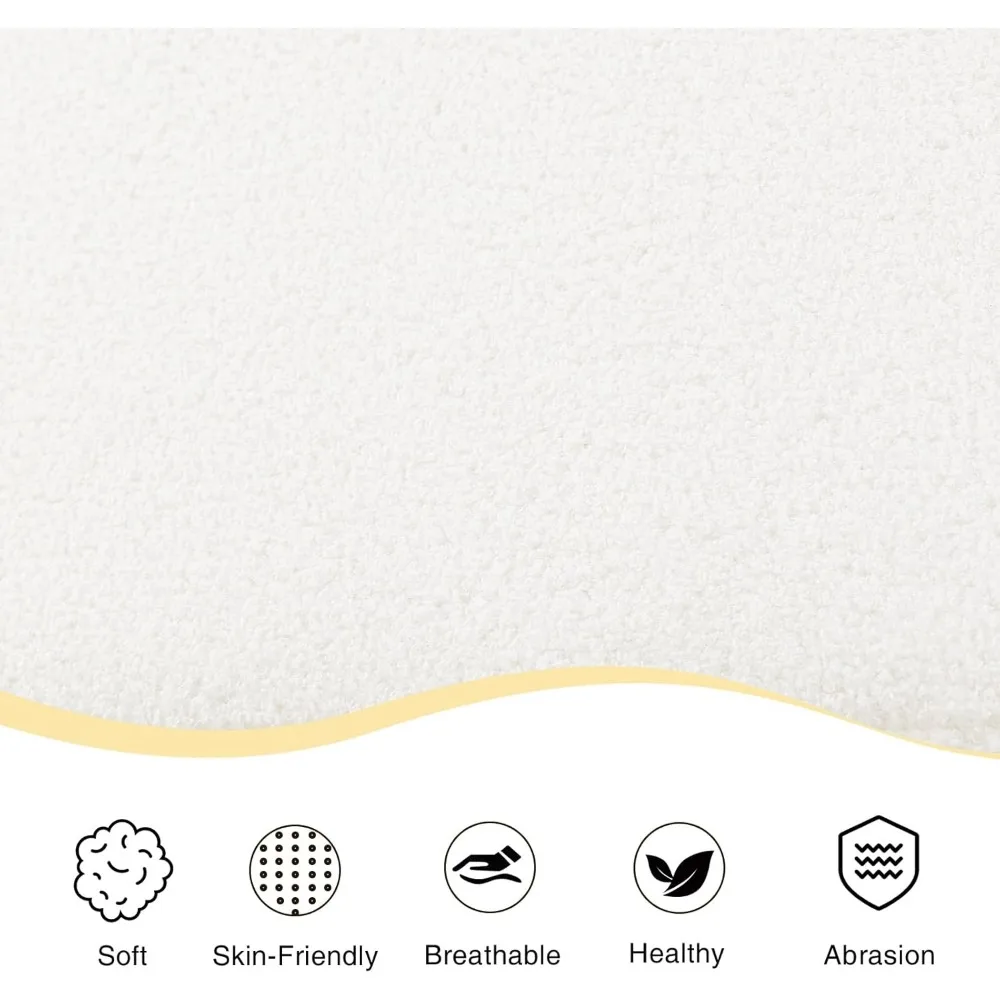
Style options range from rustic farmhouse designs featuring natural wood and black metal accents to sleek contemporary pieces with clean lines and minimalist hardware. Many hall trees offer modular components or customization options to fit specific spaces and storage needs, making them adaptable to various home layouts.
The investment in a hall tree often eliminates the need for multiple separate pieces, creating both space efficiency and visual cohesion. For households that struggle with entryway organization, these comprehensive systems provide clear designated spaces for each family member’s belongings, significantly reducing daily clutter and morning confusion.
Wall-Mounted Shelving Solutions
Wall-mounted shelving solutions transform vertical space into functional storage, making them ideal for compact entryways where floor area is limited. By lifting storage off the ground, these installations create an airy, uncluttered feel while still providing essential organization for everyday items.
The flexibility of wall-mounted options allows for creative customization based on your specific needs:
- Floating shelves in varying lengths (typically 24-48 inches) and depths (6-12 inches)
- Asymmetrical arrangements that add visual interest while conforming to available space
- Ladder-style leaning shelves that combine wall support with floor stability
- Grid systems with adjustable components for evolving storage needs
When maximizing small spaces with wall-mounted shelving, careful attention to weight capacity is essential. Most decorative floating shelves support 15-30 pounds, while shelves with visible brackets or cleated mounting systems can hold substantially more. Always verify weight ratings before installation and use appropriate anchors for your wall type.
Installation considerations include:
- Wall composition (drywall requires different anchors than plaster or concrete)
- Stud location for maximum support of heavier items
- Appropriate height placement for both visual appeal and practical access
- Clearance needed for movement through the space
Beyond practical storage, wall-mounted shelving allows for creative expression through arrangement patterns. Symmetrical installations provide classic balance, while staggered or geometric configurations add contemporary flair. The combination of wall-mounted shelving with a small bench or seating option below creates a complete entryway solution that maximizes every available inch of space.
How to Style Your Entry Furniture with Open Shelving
Styling entry furniture with open shelving requires thoughtful balance between decorative elements and practical organization. The most successful entryway displays follow fundamental design principles adapted specifically for this high-traffic area, where function must coexist with aesthetic appeal.
The golden ratio for entryway styling typically falls around 60% practical items and 40% decorative elements. This balance ensures your open shelving remains useful while still contributing to your home’s overall design aesthetic. Creating visual rhythm through varied heights, textures, and shapes prevents the shelving from appearing cluttered while maintaining interest.
When organizing small entryway benches and shelving, consider how items are viewed from different angles. Unlike decorative shelves in living areas, entryway storage is often seen primarily while in motion, making strong silhouettes and bold elements more effective than intricate details that might be missed.
Three fundamental styling principles for entryway open shelving include:
- Intentional grouping: Create small collections rather than scattering individual items
- Negative space: Leave breathing room between objects to prevent visual overwhelm
- Functional zoning: Designate specific areas for practical versus decorative items
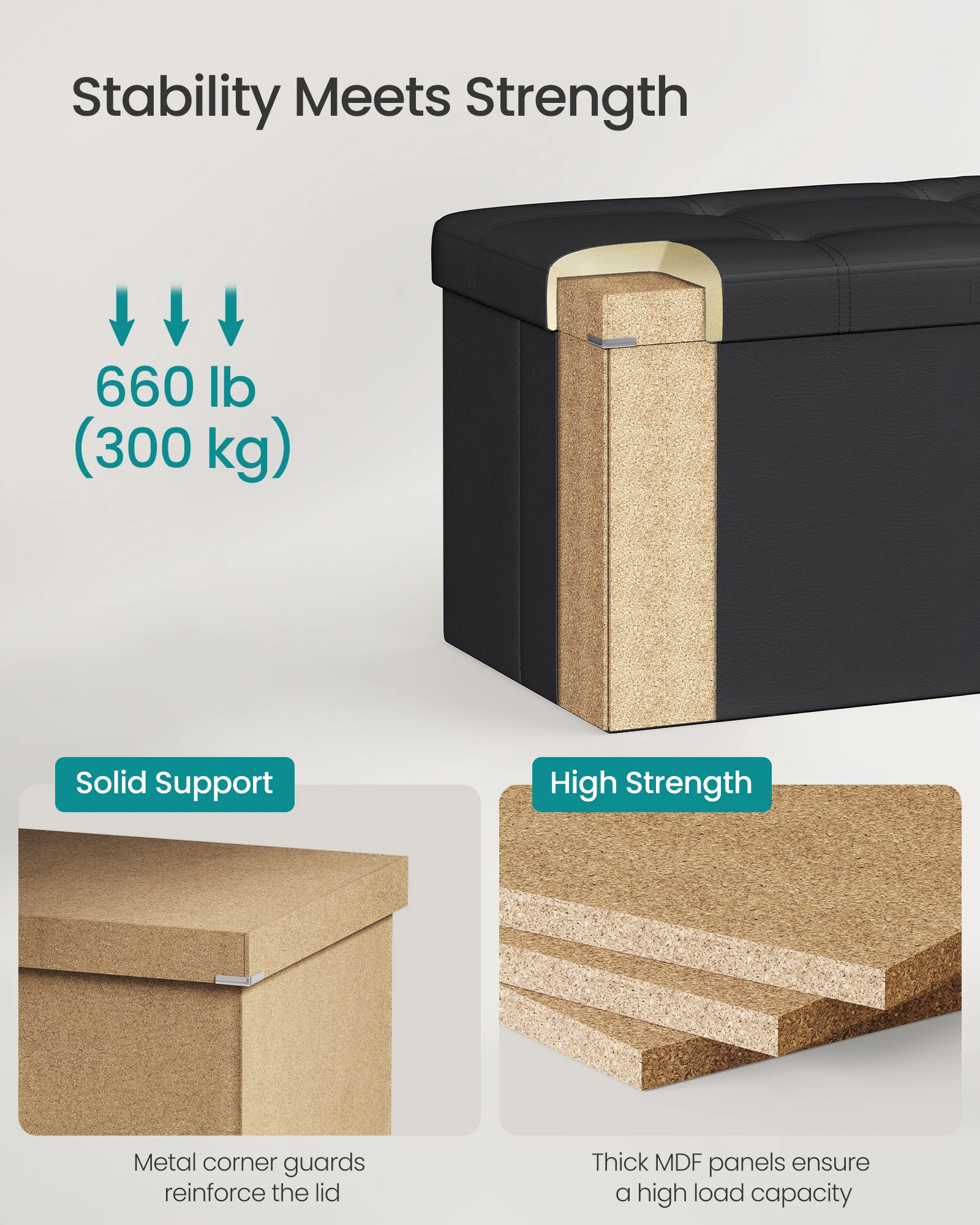
Seasonal rotation keeps your entryway fresh and responsive to changing needs. Lightweight fabrics and botanical elements in summer can transition to richer textures and warmer tones in winter, all while maintaining the core organization system that keeps daily life running smoothly.
Decorative Elements for Open Shelving
Selecting the right decorative elements transforms functional entryway shelving into a thoughtfully designed welcome space. The key is choosing items that enhance rather than impede the practical purpose of this high-traffic area.
For modern entryway benches and contemporary shelving, consider these display-worthy additions:
- Small framed artwork or photographs (5×7 or 8×10 frames work well without overwhelming)
- Sculptural objects with interesting silhouettes visible from multiple angles
- Compact plants like succulents or small ferns that add life without requiring extensive care
- Decorative boxes that serve double-duty as storage for small items
- Books with attractive spines arranged both horizontally and vertically
- Seasonal elements that can be easily swapped (mini pumpkins in fall, evergreen sprigs in winter)
Creating visual interest relies on thoughtful variation in several dimensions:
- Height variation: Combine tall, medium, and short elements within each shelf section
- Texture contrast: Pair smooth surfaces (glass, polished metal) with organic textures (woven baskets, natural wood)
- Color coherence: Limit your palette to 3-4 complementary colors that coordinate with your overall home design
- Scale consideration: Choose items proportional to your shelf depth (typically 8-12 inches for most entryway furniture)
The most successful styling follows the designer’s rule of odd numbers and asymmetry—groupings of three or five items often create more dynamic visual interest than even-numbered arrangements. This approach creates natural balance without rigid symmetry, allowing the eye to move comfortably across the display.
Personal touches make your entryway uniquely welcoming. Consider incorporating meaningful items like a small memento from travels, a family heirloom, or artwork created by family members. These elements transform generic storage into a true reflection of your household while still maintaining the functionality needed for daily comings and goings.
Practical Organization for Entryway Open Shelving
Effective organization transforms open shelving from a potential clutter magnet into a streamlined system that enhances daily routines. The key lies in creating intuitive systems that accommodate the natural flow of items entering and leaving your home.
When organizing entryway shelving, consider implementing a zone-based approach:
- Immediate access zone: Top shelves or surfaces for daily essentials (keys, sunglasses, transit cards)
- Secondary access zone: Middle shelves for items used several times weekly (dog leash, reusable bags)
- Seasonal storage zone: Lower or less accessible shelves for items that rotate with the seasons
For households with multiple members, dedicated zones for each person prevent confusion and misplaced items. This can be as simple as assigned baskets or designated shelf sections, particularly important for children’s items like school supplies and smaller accessories.
Best small benches for entryways often include combination storage that works seamlessly with open shelving systems. The bench surface serves as a transitional spot for items being sorted, while shelving provides their permanent home, creating a natural workflow for processing items coming into the house.
The most sustainable organization systems account for both functional needs and aesthetic preferences. Items that are frequently used should remain visible and accessible, while visually distracting necessities can be concealed in decorative containers that complement your style. This balanced approach maintains the visual appeal of open shelving while maximizing its practical benefits.
Storage Solutions for Open Shelving
The right storage containers transform open shelving from potential chaos to organized elegance. The visibility of open shelving makes container selection particularly important, as these elements become part of your home’s visual landscape while serving crucial organizational functions.
Effective storage solutions for entryway open shelving include:
- Woven baskets: Add texture and warmth while concealing smaller items
- Decorative boxes: Provide structured storage with style-enhancing patterns or materials
- Metal or wooden trays: Create contained zones for corralling small items
- Clear containers: Allow visibility of contents when needed (good for children’s items)
- Fabric bins: Offer softness and flexibility for items of varying sizes
When selecting containers for space-saving entry benches in small homes, consider both dimension compatibility and visual coherence. Containers should fit comfortably within shelf dimensions with at least 1-2 inches of clearance for easy removal, and their style should complement rather than compete with the furniture itself.
Color coordination creates visual calm even with varied container types. Choose storage pieces within the same color family or with complementary tones to create a cohesive look across different shelving sections. This approach allows functional diversity while maintaining aesthetic harmony.
Strategic labeling enhances functionality without compromising style. For frequently accessed family items, consider subtle labeling methods like small tags on basket handles or color-coding systems that family members can easily recognize. This detail is particularly valuable for households with children, creating clear organization systems that promote independence.
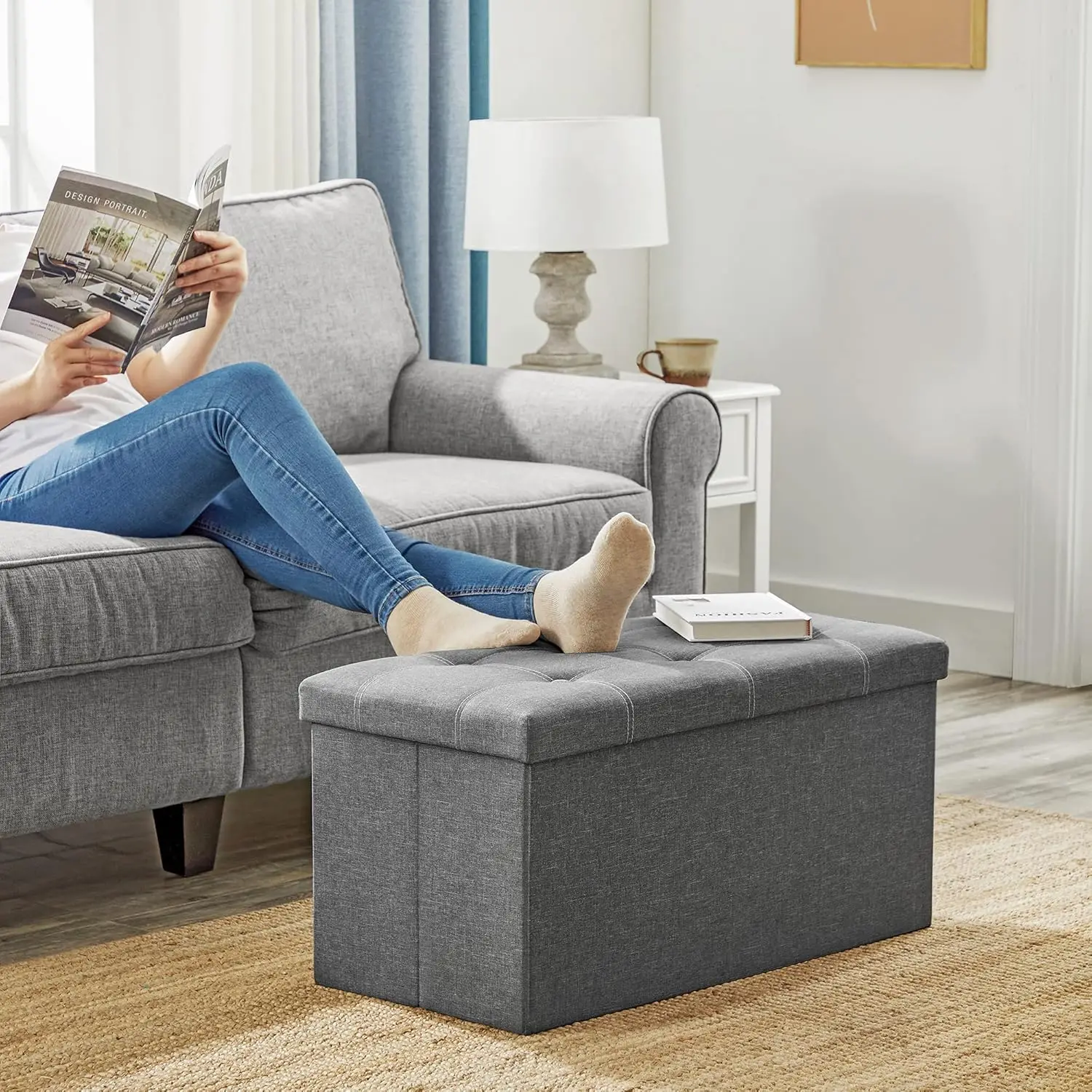
Buying Guide: How to Choose the Perfect Entry Furniture with Open Shelving
Selecting the ideal entry furniture with open shelving begins with a thorough assessment of your specific space constraints and household needs. Before purchasing, measure your available area carefully, noting not just the obvious dimensions but also considering clearance zones for movement, door swings, and traffic patterns.
Key measurements to record include:
- Wall width available for furniture placement
- Floor depth from wall to required pathway clearance
- Height restrictions (ceiling height, light fixtures, wall art)
- Door swing arcs that might interfere with furniture placement
- Electrical outlet locations that need to remain accessible
Beyond physical measurements, assess your household’s specific entryway habits and storage requirements. A complete guide for choosing compact benches can help determine the right balance between seating and storage needs, while exploring entryway furniture with shoe compartments addresses specialized storage for footwear.
Consider these functional questions to narrow your selection:
- How many family members need dedicated storage space?
- What specific items regularly accumulate in your entryway (mail, keys, bags, sports equipment)?
- Do you need seating for putting on shoes or setting down packages?
- How much display space versus concealed storage would best serve your needs?
- Does your climate require storage for seasonal items like umbrellas or winter accessories?
Matching your entry furniture to your home’s architectural style creates visual cohesion. Traditional homes often benefit from furniture with classic lines and warmer wood tones, while contemporary spaces may call for cleaner silhouettes and mixed material construction. The entryway sets expectations for the rest of your home, so choosing furniture that aligns with your overall aesthetic creates a harmonious transition from outside to inside.
Material Quality and Durability Factors
The material composition of your entry furniture significantly impacts both its longevity and maintenance requirements. Since entryways endure heavy daily use, investing in quality materials pays dividends through extended furniture life and sustained appearance.
Wood entryway benches represent the most traditional option, with varying characteristics based on wood type:
- Solid hardwoods (oak, maple, walnut): Exceptional durability, natural beauty, resistant to dents, highest price point
- Softwoods (pine, cedar): Lighter weight, more affordable, more susceptible to scratches and dents
- Engineered wood (MDF, plywood with veneer): Cost-effective, stable, requires careful moisture management
Metal components add structural strength and contemporary appeal:
- Steel: Maximum durability with industrial aesthetic, heavier weight
- Aluminum: Lighter weight, corrosion-resistant, modern appearance
- Wrought iron: Traditional elegance with substantial visual weight
Glass shelving creates visual lightness but requires special considerations:
- Tempered glass: Safety feature that prevents dangerous shattering
- Thickness requirements: Minimum 8mm for shelving applications
- Edge treatment: Polished edges prevent chips and cuts
When evaluating construction quality, examine these critical indicators:
- Joinery methods (dovetail and mortise-and-tenon connections indicate higher quality)
- Hardware robustness (look for substantial hinges and drawer glides)
- Finish consistency (even application without drips or thin spots)
- Weight capacity specifications (higher ratings typically indicate stronger construction)
The finish applied to materials significantly impacts both appearance and maintenance requirements. Polyurethane provides excellent protection but can appear plastic-like, while oil finishes offer a natural look but require more frequent refreshing. For high-traffic entryways, look for furniture with multi-layer finishes that resist scratching and moisture damage.
Space-Saving Strategies for Small Entryways
Maximizing functionality in compact entryways requires strategic furniture selection and thoughtful space planning. Even the smallest entrance can become efficiently organized with the right approach to scale and multipurpose solutions.
For truly limited spaces, consider these space-optimizing approaches:
- Floating furniture that leaves floor space visible, creating a sense of openness
- Corner-oriented pieces that utilize often-wasted angular spaces
- Wall-mounted options that provide function without consuming floor area
- Nested or expandable pieces that adapt to changing needs
Small entryway benches designed specifically for compact areas typically range from 24-36 inches in width—significantly narrower than standard sizes. Look for models with tapered legs or open bases that allow visibility through the piece, reducing visual weight in the space.
Vertical storage maximizes limited square footage by utilizing wall height instead of floor area. Installing space-saving entryway seating solutions with overhead shelving or hooks creates a complete organization station with minimal footprint. This approach is particularly effective in apartments and smaller homes where dedicated entryway space may be extremely limited.
Strategic mirror placement serves double duty in small entryways—providing both the practical function of a last-minute appearance check while visually expanding the perceived space through reflection. Positioning a mirror to reflect light (either natural from windows or artificial from fixtures) further enhances the sense of openness.
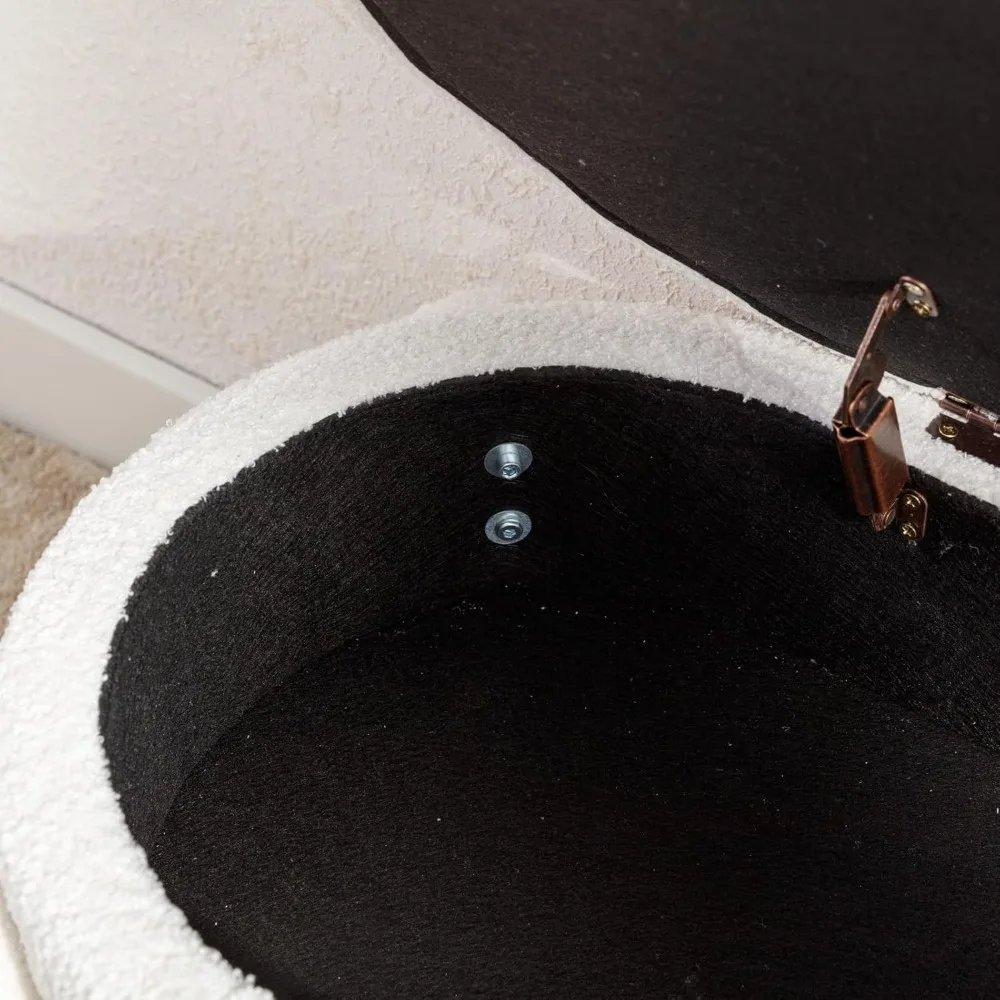
Color selection significantly impacts spatial perception. Lighter tones recede visually, making furniture appear less imposing in tight quarters. Consider pieces with lighter finishes for the body with selective darker accents for visual interest without overwhelming the space.
Multi-Functional Entry Furniture for Modern Living
Today’s lifestyle demands have transformed entry furniture from simple storage into multitasking solutions that address evolving household needs. Modern entry pieces with open shelving now incorporate features that respond to contemporary challenges like device charging, package security, and transitional workspace requirements.
Innovative multi-functional features increasingly found in today’s entry furniture include:
- Integrated USB charging stations discreetly built into surfaces or shelving
- Mail sorting components with designated spots for different document types
- Package security features like concealed compartments or lockable sections
- Convertible elements that transform from seating to work surfaces as needed
- Smart storage that accommodates technology alongside traditional entryway items
Affordable entryway bench solutions often incorporate these modern features without premium pricing through clever design rather than expensive technology integration. The key is identifying which multi-functional elements truly serve your household’s specific patterns rather than paying for capabilities you won’t utilize.
Space efficiency remains paramount in multi-functional design. The most successful pieces consolidate several necessary functions without increasing their physical footprint, creating more utility within the same dimensional constraints. This consolidation reduces the need for multiple separate furniture items, decreasing visual clutter while increasing functional capacity.
As remote work and flexible arrangements become more common, entry areas increasingly serve as transitional spaces between professional and personal life. Furniture that accommodates brief work sessions or provides organization for portable office equipment helps maintain boundaries while acknowledging the blended nature of contemporary living.
Entryway Bench with Cushion, Mudroom Bench with Cushion, Shoe Bench for Entryway
$1,186.63 Select options This product has multiple variants. The options may be chosen on the product pageCoat Rack Shoe Bench, Corner Entryway Bench, Corner Hall Tree, Shoe Bench for Entryway
$313.58 Select options This product has multiple variants. The options may be chosen on the product pageEntryway Bench with Back, Modern Entryway Bench, Shoe Bench for Entryway
Price range: $463.13 through $474.44 Select options This product has multiple variants. The options may be chosen on the product pageEntryway Bench with Shelf Storage, Shoe Bench for Entryway, Shoe Storage Bench
$194.08 Select options This product has multiple variants. The options may be chosen on the product pageCorner Entryway Bench, Entryway Bench with Cushion, Modern Entryway Bench, Shoe Bench for Entryway
$476.34 Select options This product has multiple variants. The options may be chosen on the product pageBench with Hooks and Storage, Entryway Hall Tree, Mudroom Bench with Cubbies, Mudroom Bench with Shoe Storage
$818.38 Select options This product has multiple variants. The options may be chosen on the product page
Customizing Open Shelving for Your Entryway
Standard furniture can be transformed into personalized storage solutions through thoughtful customization. Whether you’re working with an existing piece or modifying a new purchase, simple adjustments can significantly enhance both functionality and aesthetic alignment with your home.
Effective customization approaches include:
- Paint or stain modifications to match existing woodwork or color schemes
- Hardware upgrades that elevate basic pieces with distinctive knobs or pulls
- Height adjustments to create perfect entryway bench height for your family members
- Addition of hooks, dividers, or specialized storage components
- Surface treatments like decorative papers on shelf backs or protective glass tops
Semi-custom solutions bridge the gap between off-the-shelf purchases and fully custom furniture. Consider these adaptable options:
- Modular systems that allow component selection and configuration
- Adjustable shelving that modifies as storage needs change
- Mix-and-match collections designed to work together in various combinations
- Basic pieces enhanced with custom-fitted inserts or organizers
For unusual spaces or specific functional requirements, dimensional modifications make standard pieces work in non-standard settings:
- Trimming width to fit specific wall sections
- Adding height extensions for high-ceiling areas
- Creating cutouts to accommodate baseboards or electrical outlets
- Combining elements from different pieces for unique configurations
These customization approaches allow you to maintain budget control while still achieving personalized results that precisely match your entryway needs. The most successful customizations focus on enhancing the core purpose of the furniture while adding personal touches that reflect your household’s specific patterns and preferences.
Seasonal Adaptation of Entryway Open Shelving
Entryway storage needs fluctuate dramatically throughout the year, making adaptable open shelving particularly valuable for accommodating seasonal shifts. Creating systems that flex with changing requirements keeps your entryway functional regardless of weather conditions or seasonal activities.
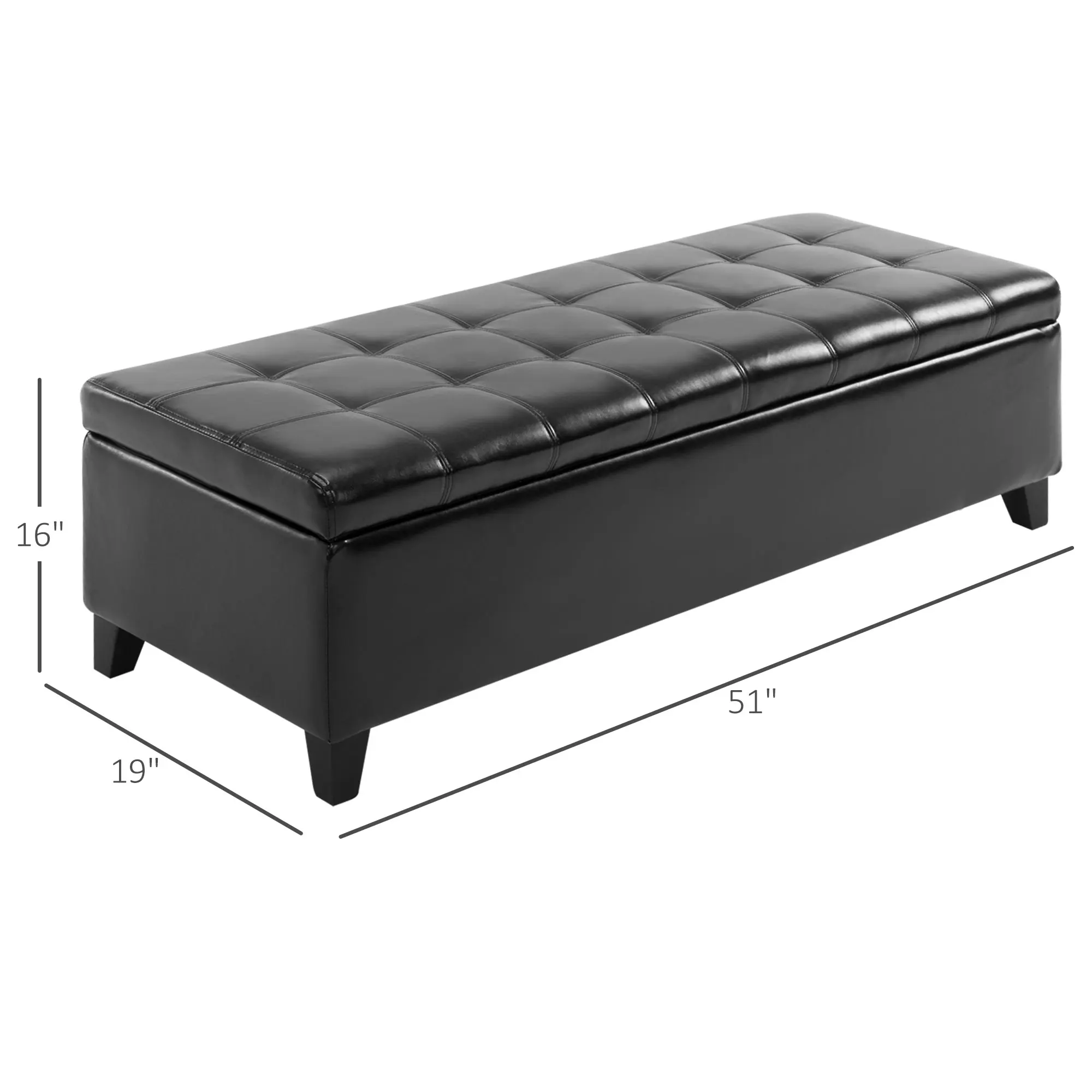
Seasonal rotation strategies maintain organization while addressing changing needs:
- Spring/Summer: Lightweight jacket storage, sunscreen and hat access, garden tool organization
- Fall: Transitional accessories (light scarves, rain gear), school supply staging, sports equipment
- Winter: Heavy coat management, boot containment, glove/hat organization, holiday decor integration
Quick seasonal refreshes can be accomplished through simple swaps:
- Changing basket liners or containers to reflect seasonal colors
- Rotating decorative elements to highlight seasonal themes
- Adjusting shelf allocation based on seasonal storage volume requirements
- Modifying lighting to address seasonal darkness (especially in winter months)
Creating “off-season” storage for items not currently in use prevents entryway overflow. Designating alternative storage locations for seasonal items maintains entryway functionality while ensuring seasonal necessities remain accessible when needed. Vacuum-sealed bags for bulky winter items during summer months or plastic bins for summer sports equipment during winter can help manage these transitions.
The key to successful seasonal adaptation lies in maintaining consistent organizational systems while allowing flexibility in what items occupy those systems. Fixed locations for keys, mail, and everyday essentials provide continuity, while designated zones for seasonal items can adapt to current needs without disrupting the overall functionality of your entryway storage.
Frequently Asked Questions About Entry Furniture with Open Shelving
How do I prevent dust accumulation on open shelving in my entryway?
Regular light dusting (weekly) prevents significant buildup. Consider using furniture polish or wax on wood surfaces to create a slight dust-resistant barrier. For difficult-to-reach areas, a small handheld vacuum with brush attachment works efficiently between deeper cleanings.
Will open shelving make my entryway look cluttered?
Not when properly organized. The key is implementing storage containers for smaller items and maintaining approximately 20-30% empty space on shelves. This visual breathing room prevents the cluttered appearance while still maximizing functional storage.
What weight can typical entryway open shelving support?
Weight capacity varies significantly based on construction. Wall-mounted floating shelves typically support 15-30 pounds per shelf, while built-in furniture shelving often handles 25-50 pounds per shelf. Always check manufacturer specifications and consider installing additional support brackets for heavy items.
How do I keep open shelving looking organized with a family?
Assign specific zones for each family member and use consistent, labeled containers that make the organization system intuitive. Implementing a “one-in-one-out” policy for entryway items and scheduling weekly quick resets (taking just 5-10 minutes) maintains order even with multiple users.
Can I install additional shelving to existing entry furniture?
In many cases, yes. Solid wood furniture can often accept carefully installed additional shelves or hooks. For manufactured pieces, look for pre-drilled adjustment holes or consider adding separate wall-mounted shelving above or alongside the existing furniture to expand capacity without modification.
How do I coordinate open shelving with the rest of my home décor?
Focus on repeating key elements from adjacent rooms—similar wood tones, complementary metal finishes, or color palette continuity. Using consistent container types throughout your home also creates visual flow from the entryway into living spaces.
Maintenance Tips for Entry Furniture with Open Shelving
Proper maintenance extends the life of your entry furniture while keeping it looking its best. Since entryway pieces endure more environmental exposure than most indoor furniture, protective routines are particularly important for preserving both function and appearance.
Develop these simple maintenance habits to protect your investment:
- Weekly quick clean: Dust open shelving and wipe down high-touch surfaces with appropriate cleaner
- Monthly deep clean: Remove all items, clean thoroughly including corners and edges, check for damage
- Quarterly wood conditioning: Apply appropriate wood conditioner to prevent drying/cracking (for wood pieces)
- Seasonal organization reset: Sort through accumulated items, remove unnecessary objects, refresh systems
Material-specific care ensures longevity:
- Wood surfaces: Clean with soft cloths slightly dampened with appropriate wood cleaner; avoid excess moisture
- Metal components: Wipe with soft cloth and mild soap solution; apply metal polish if appropriate for finish
- Glass elements: Use ammonia-free glass cleaner and lint-free cloths to prevent streaking
- Upholstered sections: Vacuum regularly with upholstery attachment; treat stains immediately according to fabric type
Protection from environmental factors significantly extends furniture life:
- Position entry furniture away from direct sunlight when possible to prevent fading
- Use protective pads under frequently moved items to prevent surface scratching
- Apply appropriate sealants to vulnerable areas like shelf edges and high-wear surfaces
- Consider seasonal humidity variations and their impact on wood furniture expansion/contraction
Prompt attention to wear indicators prevents more significant damage:
- Tighten loose hardware before movement causes structural problems
- Touch up minor finish damage before moisture can penetrate exposed wood
- Repair small upholstery issues before they expand from continued use
- Address water rings or heat marks immediately using appropriate restoration techniques
Conclusion: Creating a Welcoming Entryway with Open Shelving Furniture
Entry furniture with open shelving represents the ideal marriage of form and function—providing essential organization while contributing to your home’s aesthetic appeal. By thoughtfully selecting pieces that align with both your practical needs and design preferences, you create an entryway that efficiently manages daily traffic while setting a welcoming tone for your entire home.
The most successful entryway designs balance several key elements:
- Appropriate scale furniture that fits the available space without overwhelming it
- Sufficient storage capacity for your household’s specific needs
- Visual appeal that complements your home’s overall design direction
- Durable construction that withstands the demands of this high-traffic area
As you implement your entryway organization system, remember that flexibility remains essential. The best solutions adapt to changing household patterns, seasonal needs, and evolving storage requirements. By choosing versatile pieces and implementing thoughtful organization systems, you create an entryway that continues to serve your household effectively through various life stages.
Open shelving in the entryway offers a unique opportunity to display personality while maintaining practical organization. This visibility turns everyday items into part of your home’s visual story—transforming the simple act of coming home into a moment of both functional efficiency and personal welcome. With the right furniture and thoughtful styling, your entryway becomes not just a passageway but a perfect introduction to the life and style contained within your home.

